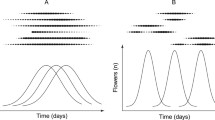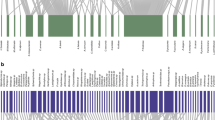Abstract
Interaction networks between plants and their floral visitors are often studied with a plant-centered approach, and the results obtained with these data may generate incomplete conclusions on network topology. Thus, we propose to elucidate how biases associated with the approach to data collection can influence the topology of interaction networks by examining species richness, interactions, generalization levels, and nestedness in three interaction matrices: plant-centered, animal-centered, and their combination. The results of the combined data indicate an increase in connectance in relation to animal-centered networks and differences in the mean degree for plants and animals, showing the importance of complementary methods of collecting data to reduce the sampling biases of each isolated method. The nestedness level was most time significant and higher in the animal-centered networks. Our work shows that the apparently specialist behavior of some visitor species may be in part circumvented with the supplementation of plant-centered data with animal-centered data, thereby leading to a result closer to that expected by theory, which predicts a more generalist behavior.



Similar content being viewed by others
References
Aguiar, W.M. (2006) Comunidade de abelhas Euglossina (Hymenoptera; Apidae) em remanescentes de mata estacional semidecidual sobre tabuleiro no Estado do Rio de Janeiro. MSc Thesis. Universidade Estadual do Norte Fluminense Darcy Ribeiro, Brazil
Almeida-Neto, M., Guimarães, P.R., Loyola, R.D., Ulrich, W. (2008) A consistent metric for nestedness analysis in ecological systems: reconciling concept and measurement. Oikos 117, 1227–1239
Armbruster, W.S. (2006) Evolutionary and ecological aspects of specialized pollination: views from the Arctic to the Tropics. In: Waser, N.M., Ollerton, J. (eds.) Plant–pollinator interactions: from specialization to generalization, pp. 260–282. University of Chicago Press, Chicago
Bascompte, J., Jordano, P., Melián, C.J., Olesen, J.M. (2003) The nested assembly of plant–animal mutualistic networks. Proc. Natl. Acad. Sci. U S A 100, 9383–9387
Basilio, A.M., Medan, D., Torretta, J.P., Bartoloni, N.J. (2006) A year-long plant–pollinator network. Austral Ecol. 31, 975–983
Biesmeijer, J.C., Slaa, E., Castro, M.S., Viana, B.F., Kleinert, A.M.P., Imperatriz-Fonseca, V.L. (2005) Connectance of Brazilian social bee-food plant networks is influenced by habitat, but not by latitude, altitude or network size. Biota. Neotrop. 5, 1–9 doi:10.1590/S1676-06032005000100010
Bonaldo, A.B., Marques, M.A.L., Pinto-da-Rocha, R., Gardner, T. (2007) Species richness and community structure of arboreal spider assemblages in fragments of three vegetational types at Banhado Grande wet plain, Gravataí River, Rio Grande do Sul, Brazil. Iheringia Sér. Zool. 97, 143–151
Bosch, J., González, A.M.M., Rodrigo, A., Navarro, D. (2009) Plant–pollinator networks: adding the pollinator’s perspective. Ecol. Lett. 12, 409–419
Carvalho, F.A., Rodrigues, V.H.P., Kilka, R.V., Siqueira, A.S., Araújo, G.M., Schiavini, I. (2008) Composição florística, riqueza e diversidade de um Cerrado sensu-stricto no sudeste do Estado de Goiás. Biosci. J. (Uberlândia) 24, 64–72
Chacoff, N.P., Vázquez, D.P., Lomáscolo, S.B., Stevani, E.L., Dorado, J., Padrón, B. (2012) Evaluating sampling completeness in a desert plant–pollinator network. J. Anim. Ecol. 81, 190–200
Delgado, J.M., Barbosa, A.F., Silva, C.E., Silva, D.A., Zancheta, D., Gianotti, D., Pinheiro, G.S., et al. (2004) Plano de manejo integrado das Unidades de Conservação de Itirapina. Instituto Florestal do Estado de São Paulo, SP
Eickwort, G.C., Ginsberg, H.S. (1980) Foraging and mating behaviour in Apoidea. Annu. Rev. Entomol. 25, 421–446
Erdtman, G. (1960) The acetolized method: a revised description. Sven. Bot. Tidskr. 54, 561–564
Felfili, M.C., Felfili, J.M. (2001) Diversidade alfa e beta no Cerrado sensu stricto da Chapada Pratinha, Brasil. Acta Bot. Bras. 15, 243–254
Felfili, J.M., Silva, M.C. (2005) Diversidade alfa e beta no cerrado sensu strictu, Distrito Federal, Goiás, Minas Gerais e Bahia. In: Scariot, A., Souza-Silva, J.C., Felfili, J.M. (eds.) Cerrado: ecologia, biodiversidade e conservação, pp. 141–154. Ministério do Meio Ambiente, Brasília
Forup, M., Henson, K.S.E., Craze, P.G., Memmott, J. (2008) The restoration of ecological interactions: plant–pollinator networks on ancient and restored heathlands. J. Appl. Ecol. 45, 742–752
Goldwasser, L., Roughgarden, J. (1997) Sampling effects and the estimation of food-web properties. Ecology 78, 41–54
Gottsberger, G. (1986) Some pollination strategies in neotropical savannas and forests. Plant Syst. Evol. 152, 29–45
Greenleaf, S.S., Williams, N.M., Winfree, R., Kremen, C. (2007) Bee foraging ranges and their relationship to body size. Oecologia 153, 589–596
Guimarães, P.R., Guimarães, P. (2006) Improving the analyses of nestedness for large sets of matrices. Environ. Model. Software 21, 1512–1513
Guimarães, P.R., Aguiar, M.A.M., Bascompte, J., Jordano, P., Reis, S.F. (2005) Random initial condition in small Barabasi-Albert networks and deviations from the scale-free behavior. Phys. Rev. E 71, 037101. doi:10.1103/PhysRevE.71.037101
Jordano, P. (1987) Patterns of mutualistic interactions in pollination and seed dispersal: connectance, dependence asymmetries, and coevolution. Am. Nat. 129, 657–677
Jordano, P., Bascompte, J., Olesen, J.M. (2003) Invariant properties in coevolutionary networks of plant–animal interactions. Ecol. Lett. 6, 69–81
Jordano, P., Bascompte, J., Olesen, J.M. (2006) The ecological consequences of complex topology and nested structure in pollination webs. In: Waser, N.M., Ollerton, J. (eds.) Specialization and generalization in plant–pollinator interactions, pp. 173–199. University of Chicago Press, Chicago
Kanstrup, J., Olesen, J.M. (2000) Plant–flower visitor interactions in a neotropical rain forest canopy: community structure and generalization level. In: Totland, Ø., Armbruster, W., Fenster, C., Molau, U., Nilsson, L., Olesen, J., Ollerton, J., et al. (eds.) The Scandinavian Association for Pollination Ecology honours Knut Fægri, pp. 33–42. The Norwegian Academy of Science and Letters, Oslo
Lewinsohn, T.M., Loyola, R.D., Prado, P.I. (2006) Matrizes, redes e ordenações: a detecção de estrutura em comunidades interativas. Oecol. Bras. 10, 90–104
Lima-Ribeiro, M.S. (2007) Distribuição espacial de espécies arbóreas em fragmentos de cerrado sentido restrito no Planalto Central Brasileiro-GO. Biociências (Porto Alegre) 15, 160–165
Medan, D., Basilio, A.M., Devoto, M., Bartoloni, N.J., Torretta, J.P., Petanidou, T. (2006) Measuring generalization and connectance in temperate, year-long active systems. In: Waser, N., Ollerton, J. (eds.) Plant–pollinator interactions: from specialization to generalization, pp. 245–259. University of Chicago Press, Chicago and London
Medan, D., Perazzo, R.P.J., Devoto, M., Burgos, E., Zimmermann, M.G., Ceva, H., Delbue, A.M. (2007) Analysis and assembling of network structure in mutualistic systems. J. Theor. Biol. 246, 510–521
Nielsen, A., Bascompte, J. (2007) Ecological networks, nestedness and sampling effort. J. Ecol. 95, 1134–1141
Olesen, J.M., Jordano, P. (2002) Geographic patterns in plant–pollinator mutualistic networks. Ecology 83, 2416–2424
Olesen, J.M., Bascompte, J., Dupont, Y.L., Jordano, P. (2007) The modularity of pollination networks. Proc. Natl. Acad. Sci. U. S. A. 104, 19891–19896
Petanidou, T., Kallimanis, A.S., Tzanopoulos, J., Sgardelis, S.P., Pantis, J.D. (2008) Long-term observation of a pollination network: fluctuation in species and interactions, relative invariance of network structure and implications for estimates of specialization. Ecol. Lett. 11, 564–575
Quinn, G.P., Keough, M.J. (2002) Experimental design and data analysis for biologists. Cambridge University Press, New York
Ramalho, M., Kleinert-Giovannini, A. (1986) Some aspects of the utilization of pollen analysis in ecological research. Apidologie 17, 159–174
Raw, A. (1974) Preferences of three Osmia species (Hymenoptera). Oikos 25, 54–60
Rezende, E.L., Jordano, P., Bascompte, J. (2007) Effects of phenotypic complementarity and phylogeny on the nested structure of mutualistic networks. Oikos 116, 1919–1929
Rico-Gray, V., Oliveira, P.S. (2007) The ecology and evolution of ant–plant interactions. The University of Chicago Press, Chicago
Salgado-Labouriau, M.L. (1973) Contribuição à Palinologia dos Cerrados. Academia Brasileira de Ciências, Rio de Janeiro
Silva, C.I., Silva, C.M., Santos, F.A.R., Bauermann, S.G. (2012) O Uso da palinologia como ferramenta em estudos sobre ecologia e conservação de polinizadores no Brasil. In: Imperatriz-Fonseca, V.L., Canhos, D.A.L., Alves, D.A., Saraiva, A.M. (eds.) Polinizadores no Brasil: Contribuição e perspectivas para a biodiversidade, uso sustentável, conservação e serviços ambientais. Ed. University of São Paulo, São Paulo
Srinivasan, U.T., Dunne, J.A., Harte, J., Martinez, N.D. (2007) Response of complex food webs to realistic extinction sequences. Ecology 88, 671–682
Stang, M., Klinkhamer, P.G.L., van der Meijden, E. (2007) Assymetric specialization and extinction risk in plant-flower visitor webs: a matter of morphology or abundance? Oecologia 151, 442–453
StatSoft Inc (2007) STATISTICA (data analysis software system), version 8.0. www.statsoft.com
Tscheulin, T., Neokosmidis, L., Petanidou, T., Settele, J. (2011) Influence of landscape context on the abundance and diversity of bees in Mediterranean olive groves. Bull. Entomol. Res. 101, 557–564
Vázquez, D.P., Aizen, M.A. (2006) Community-wide patterns of specialization in plant–pollinator interactions revealed by null models. In: Waser, N.M., Ollerton, J. (eds.) Specialization and generalization in plant–pollinator interactions, pp. 201–219. University of Chicago Press, Chicago
Vergeron, P. (1964) Interprétation statistique des résultats en matière d’analyse pollinique des miels. Ann. Abeille 7, 349–364
Vianna, M.R. (2010) Fatores que influenciam métricas topológicas de redes de interação entre plantas e visitantes florais: Uma abordagem metodológica. PhD Thesis. University of São Paulo, São Paulo, Brazil
Waser, N.M. (1986) Flower constancy: definition, cause, and measurement. Am. Nat. 127, 593–603
Wcislo, W.T., Cane, J.H. (1996) Floral resource utilization by solitary bees (Hymenoptera: Apoidea) and exploitation of their stored foods by natural enemies. Annu. Rev. Entomol. 41, 257–286
Yodzis, P. (1980) The connectance of real ecosystems. Nature 284, 544–545
Acknowledgments
National Council for Scientific and Technological Development (CNPq) supported this work with a fellowship (Process nº 141893/2007-9 to M.R.V.) and with a Research Productivity Fellowship (Process nº 301220/2009-3 to C.P.L.). We thank Dr. F A Silveira (UFMG) and Dr. G Mello (UFPR) for the identification of floral visitors, Ms. L Borges (USP) for the identification of plant species, and CO Gridi-Papp for the English translation.
Author information
Authors and Affiliations
Corresponding author
Additional information
Manuscript editor: Klaus Hartfelder
Réseaux d’interactions dans un Cerrado brésilien: qu’est-ce qui change quand vous ajoutez une information palynologique aux données concernant les espèces visitant les fleurs?
Réseaux de pollinisateurs / topologie / interaction plante-animal / données palynologiques / Cerrado
Interaktionsnetzwerke für Bestäuber im Cerrado-Biom Brasiliens: Was ändert sich, wenn Information zu Pollen in die Analysen einbezogen wird?
Bestäubernetzwerk / Topologie / Tier-Pflanzen-Interaktion / Palynologiedaten / Cerrado
Rights and permissions
About this article
Cite this article
Vianna, M.R., da Luz, C.F.P. & de Matos Peixoto Kleinert, A. Interaction networks in a Brazilian cerrado: what changes when you add palynological information to floral visitor data?. Apidologie 45, 418–430 (2014). https://doi.org/10.1007/s13592-013-0256-z
Received:
Revised:
Accepted:
Published:
Issue Date:
DOI: https://doi.org/10.1007/s13592-013-0256-z




